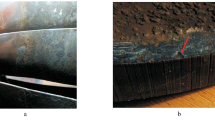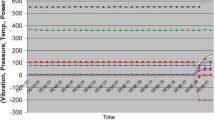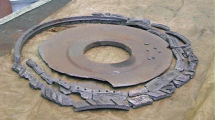Abstract
Evaluation of a gas turbine disk revealed a crack in the blade attachment area. The subsequent effort to understand the origin of this crack led to a series of analyses that included computing the stresses on the attachment, characterization of fatigue crack growth, and a model for fretting fatigue crack growth. These elements were brought together to simulate the conditions that led to the cracking. It is concluded that the crack was probably caused by fretting fatigue induced by the stresses related to normal takeoff and landing cycles and exacerbated by aircraft maneuvers, and that short periods of blade resonance may have contributed to the cracking. If material had not been removed from the attachment surface of the disk by service-induced wear, it is likely more cracks would have been found.
Similar content being viewed by others
References
D.L. Davidson: “Damage Mechanisms in High Cycle Fatigue,” Final Report to Air Force Office of Scientific Research, Contract F49620-96-0037, Southwest Research Institute, January 1999.
A.E. Giannakopoulos, T.C. Lindley, and S. Suresh: Acta Mater., 1998, 46, pp. 2955–68.
K.S. Chan, Y.-D. Lee, D.L. Davidson, and S.J. Hudak, Jr.: “A Fracture Mechanics Approach to High Cycle Fretting Based on the Worst Case Fret Concept, Part I: Model Development,” Int. J. Fract., 2001, 112, pp. 299–330.
K.S. Chan, D.L. Davidson, T.E. Owen, Y.-D. Lee, and S.J. Hudak, Jr.: “A Fracture Mechanics Approach to High Cycle Fretting Based on the Worst Case Fret Concept, Part II: Experimental Evaluation,” Int. J. Fract., 2001, 112, pp. 331–53.
R.E. Dundas: “Design of the Gas Turbine,” Sawyer’s Gas Turbine Engineering Handbook, Vol. 1, 2nd ed., J.W. Sawyer, ed., Gas Turbine Publications, Stamford, CT, 1972, pp. 79–150.
G.B. Sinclair and N.G. Cormier: “Contact Stresses in Dovetail Attachments: Physical Modeling,” 2000GT-356, Proc. ASME TURBOEXPO 2000, ASME, New York, NY.
G.B. Sinclair and N.G. Cormier: “Contact Stresses in Dovetail Attachments: Alleviation via Precision Crowning,” 2001GT-0550, Proc. ASME TURBOEXPO 2001, ASME, New York, NY.
C. Ruiz and K.C. Chen: C241/86, Proc. Inst. Mech. Engineers, 1986, 1, pp. 187–94.
M. Ciavarella, D.A. Hills, and G. Monno: Proc. Inst. Mech. Eng., 1998, 212(Part C), pp. 319–28.
D. Nowell and D.A. Hills: J. Strain Anal., 1987, 22, pp. 177–85.
M.P. Szolwinski, G. Harish, and T.N. Farris: Mech. Behavior Adv. Mater., 1998, 89, pp. 11–18.
Removed from service June 1997. Combined cycle count, ≈6100. Disk received from Kelly Air Logistics Center, San Antonio, TX.
D.L. Davidson: in Fatigue Behavior of Titanium Alloys, R. Boyer, D. Eylon, and G. Lutjering, ed., TMS, Warrendale, PA, 1999, pp. 89–97.
S.J. Hudak et al.: “High Cycle Fatigue of Turbine Engine Materials,” Final Report for AFRL Contract F33615-96-C-5269, Sec. 2, Southwest Research Institute, August 31, 1999.
J.O. Peters, O. Roder, B.L. Boyce, A.W. Thompson, and R.O. Ritchie: “Role of Foreign Object Damage on Thresholds for High Cycle Fatigue in Ti-6Al-4V,” Metall. Mater. Trans. A, 2000, 31, pp. 1571–83.
A.L. Dowson, M.D. Halliday, and C.J. Beevers: Mater. Des., 1993, 14, pp. 57–59.
J.A. Hines, J.O. Peters, and G. Lutjering: in Fatigue Behavior of Titanium Alloys, R. Boyer, D. Eylon, and G. Lutjering, ed., TMS, Warrendale, PA, 1999, pp. 15–22.
M.H. El Haddad, K.N. Smith, and T.H. Topper: J. Eng. Mater. Technol. (Trans. ASME), 1979, 101, pp. 42–46.
References
R.E. Dundas: “Design of the Gas Turbine,” Sawyer’s Gas Turbine Engineering Handbook, Vol. 1, 2nd ed., J.W. Sawyer, ed., Gas Turbine Publications, Stamford, CT, 1972, pp. 79–150.
G.B. Sinclair and N.G. Cormier: “Contact Stresses in Dovetail Attachments: Physical Modeling,” 2000GT-356, Proc. ASME TURBOEXPO 2000, ASME, New York, NY.
G.B. Sinclair and N.G. Cormier: “Contact Stresses in Dovetail Attachments: Alleviation via Precision Crowning,” 2001GT-0550, Proc. ASME TURBOEXPO 2001, ASME, New York, NY.
Engine Handbook, Directorate of Propulsion, Air Force Logistics Command, Wright-Patterson AFB, OH, 1991.
R.C. Weast, ed.: Handbook of Chemistry and Physics, The Chemical Rubber Co., Cleveland, OH, 1966, pp. F6-F8.
D.L. Davidson: “Damage Mechanisms in High Cycle Fatigue,” Final Report to Air Force Office of Scientific Research, Contract F49620-96-0037, Southwest Research Institute, January 1999.
M.J. He and C. Ruiz: “Fatigue Life of Dovetail Joints: Verification of a Simple Biaxial Model,” Exp. Mech., 1989, 29, pp. 126–31.
A.E. Giannakopoulos, T.C. Lindley, and S. Suresh: “Aspects of Equivalence between Contact Mechanics and Fracture Mechanics: Theoretical Connections and a Life Prediction Methodology for Fretting Fatigue,” Acta Mater., 1998, 46, pp. 2955–68.
Author information
Authors and Affiliations
Rights and permissions
About this article
Cite this article
Davidson, D.L. Gas turbine disk-blade attachment crack. J Fail. Anal. and Preven. 5, 55–71 (2005). https://doi.org/10.1361/15477020522104
Received:
Revised:
Issue Date:
DOI: https://doi.org/10.1361/15477020522104




